Ignacy Jan Paderewski, Dzieła wszystkie [Complete Works], ed. by Małgorzata Perkowska-Waszek, Kraków: Musica Iagellonica, 1997-
Volume 1: Piano Works Opp. 1-6, 8-9 (vol. ed. by Bożena Lewandowska, Małgorzata Perkowska-Waszek)
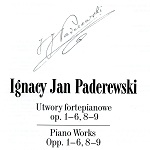
Volume I of Paderewski's Complete Works includes piano works designated with opus numbers 1-6 and 8-9, most of which were published for the first time over 100 years ago by the Berlin firm Ed. Bote und G. Bock. The present edition also contains several works which are being printed for the first time; they were not known heretofore either to biographers, or indeed to pianists performing Paderewski's compositions. We are speaking here of the youthful Suite in E-flat major op. 1 (designated in the present edition with the number op.1[a] to differentiate it from Zwei Klavierstücke op. 1 according to the Berlin edition); as well as the Old Suite (for three voices) op. 3; and the Mazurka in G major (part of the Polish Dances op. 9 collection), which, in the earliest version, was the first dance in the cycle; it was not, however, included in the Berlin edition. We present this Mazurka at the end of the volume as op. 9 no. 1[a]. The above works represent a very early period in Paderewski's artistic activity, for they were written between 1879 and 1884 – long before, as a pianist, he became a world-famous musician.
[from the Preface by Małgorzata Perkowska-Waszek]
Volume 2: Piano Works Opp. 10-12, 14-16 (vol. ed. by Aleksandra Patalas)
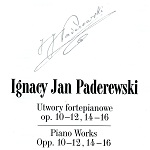
Volume II of Paderewski's Complete Works contains works for piano, op. 10-12 as well as 14-16, which once belonged to the composer's concert repertoire and were known to the general public nearly everywhere in the world. These are mainly piano miniatures such as, among others, the Chant d'Amour from op. 10, the Minuet, Sarabande, and Cracovienne fantastique from op. 14; beyond this, the Légende, Mélodie and Nocturne from op. 16. The Minuet in G major op. 14 no. 1 attained quite legendary popularity, and is today no doubt the most universally recognized of Paderewski's works. The present volume also contains larger forms, among others the Variations in a minor op. 11, Thème varié op. 16 no. 3, or the Toccata ‘Dans le désert' op. 15. These works, as well, were once well-known; they were especially appreciated and propagated by Anette Essipova, at that time a famous pianist in Europe. Favorable opinions regarding these works were also expressed by reviewers, writing about Paderewski's oeuvre shortly before his Paris debut. A separate place in this volume is also assigned to two cycles of Tatra highland songs and dances, op. 12, arranged by Paderewski for piano 2 and 4 hands. These are the earliest examples in which original Polish highland folklore is used on the ground of piano literature, and this fact was positively appraised by, among others, Władysław Górski on the pages of the Tygodnik Ilustrowany, not long after the works were performed. Paderewski's Tatra Album did not stand the test of time and, though it is performed from time to time today, it represents rather a musical curiosity – an example of salon-, or even humoresque-style interpretation of folklore by Paderewski.
[from the preface by Małgorzata Perkowska-Waszek]
Volume 3: Piano Works Op. 21, 23 (vol. ed. by Alicja Jarzębska)
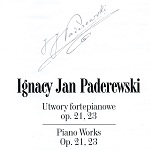
Volume III of Paderewski's Complete Works contains two monumental compositions for piano, the Sonata in e-flat minor op. 21 and the Variations and Fugue in e-flat minor op. 23, both completed in 1903, when Paderewski was composing the last works in his output. During a relatively lengthy, year-long break in concert tours, while the artist was staying at his Swiss residence, Riond-Bosson in Morges, he also composed the cycle of 12 Songs op. 22 to words by Catulle Mendès and made sketches for his Symphony in b-minor.
However, the first sketches for the Sonata op. 21 come from as early as 1887, i.e. from the time of his piano studies in Vienna; the success which Paderewski enjoyed after his Paris debut in March 1888 distanced him from composing work for a long time, and it is for this reason, among others, that the piano sonata [...] was completed many years later. [...] The Variations and Fugue in e-flat minor op. 23 were completed – similarly to the Sonata op. 21 – in 1903, but the composer began work on the piece already in 1885, when he was composing two other cycles of variations for piano: Variations and Fugue in a minor op. 11 and Thème varié in A major op. 16. These works were written at the beginning of his career as a composer; they still bear the marks of a youthful compositional style. Conversely, the Variations and Fugue op. 23, completed nearly 20 years later, are a work in which the characteristic traits of an already experienced composer's compositional technique are brought out.
[from the preface by Alicja Jarzębska]
Volume 4: Piano Works without opus numbers (vol. ed. by Andrzej Sitarz)
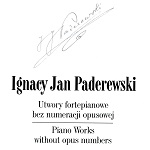
The present book, Volume IV of Paderewski's Complete Works, contains his following piano compositions without opus numbers: Waltz in F major, Mazurka in F major, Impromptu in F major, two canons entitled Z uczniowskiej teki [From a Student's Notebook], two Intermezzi, Powódź [The Flood], Miniature in E-flat major, Mazurka in G major, and Canzona: the Song without Words. Except for the Canzona, all of these works come from Paderewski's juvenilia. A few of them (Waltz in F major, Mazurka in F major, and Miniature in E-flat major) have never been published before, and have survived exclusively in manuscript form. Some have been printed only once in occasional prints (The Flood, Mazurka in G major), or they were published in a supplement to the periodical Echo Muzyczne (Impromptu in F major, two canons, two Intermezzi). Canzona, a later composition, and the best qualified out of this group to be classified as a mature work, was published several times during the composer's lifetime. The majority of these works have been re-discovered by Małgorzata Perkowska-Waszek during her research for source materials indispensable to the preparation of her Thematic Catalogue of Works by Paderewski.
[from the preface by Andrzej Sitarz]
Volume 5: Chamber Works (vol. ed. by Barbara Krzemień-Kołpanowicz)
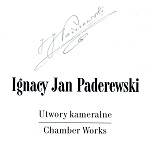
Volume V of Paderewski's Complete Works encompasses four chamber compositions: Sonata in a minor op. 13 for violin and piano, as well as three works which were recovered between 1986 and 1988, so that until now they have not figured in the lists of compositions of any of the authors writing about Paderewski; nor, to date, have they been published. These are: two miniatures for violin and piano – the Song in F major, and the Romance in A major op. 7[b] – as well as the Variations in F major for string quartet. Thus, the Sonata in a minor has been completely wrongly assumed to be Paderewski's only chamber work.
[from the preface by Małgorzata Perkowska-Waszek]
Volume 6: Songs (vol. ed. by Małgorzata Perkowska-Waszek)
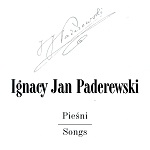
The present Volume VI of Paderewski's Complete Works contains all surviving songs for voice with piano accompaniment, together with the only song composed by Paderewski for male choir with piano or wind ensemble accompaniment, entitled Hej, Orle Biały! Hymn bojowy… [Hey, White Eagle, Military Anthem..]. It was decided to include this song as well in this collection because the song's modest dimensions do not justify separate publication, while the last volume planned in this series – Miscellaneous Works – will contain unfinished works, sketches and projects. Also included in this volume, besides all songs by Paderewski known to date (op. 7, op. 18, op. 22), is an as yet unpublished song entitled Konwalijka [The Lily of the Valley], which was composed as the fifth in a series of songs to words by Adam Asnyk, but not published, as well as a little-known song to Théophile Gautier's French text Dans la forêt. This composition was published in 1896 in London and New York, probably in a small print run, so that in Poland, the only surviving copies of this printing are located at the Paderewski Center in Kraków, where they arrived in 1974, together with a collection of books from Paderewski's home in Switzerland. One copy of the song is also in the possession of the Library of Congress in Washington.
[from the preface by Małgorzata Perkowska-Waszek]
Volume 8: Polish Fantasy on Original Theme Op. 19 (vol. ed. by Małgorzata Perkowska-Waszek)

The present Volume VIII of Paderewski's Complete Works comprises the Fantazja polską na tematy własne gis-moll [Polish Fantasy on Original Theme in G-sharp minor] for piano and orchestra. Paderewski's third orchestral piece (aside from his youthful Overture and Piano Concerto in A minor op. 17); in 1909 he would also write the monumental Symphony in B minor, the last important piece to be composed by the great pianist. From his debut in 1888 in Paris, Paderewski devoted himself almost entirely to performing and soent many months of the year on concert tours, and only in the summer months, whilst on vacation, did he attempt to return to composition during the 1888-1903 period.
[from the preface by Małgorzata Perkowska-Waszek]
Volume 10: Overture; Suite(vol. ed. by Wojciech M. Marchwica)
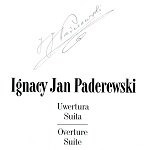
The orchestral compositions by I.J. Paderewski published in Volume X of his Complete Works, Overture in E-flat major for symphony orchestra and Suite in G major for string orchestra, come from composer's juvenile period. They are not as yet widely known either to music-lovers or to musicologists, as they have not been published before. [...] The autographs containing these two works were discovered in 1986 by Małgorzata Perkowska-Waszek, in the library collection of the Warsaw Academy of Music, where the manuscript of the Suite and of the final part of the Overture (from bar 298) was kept. After Second World War, the manuscript with the first 297 bars of the Overture was sent from Switzerland do Kraków, along with Paderewski's library, and it is now in the collection of the Paderewski Centre in Kraków. Only after the missing part of the manuscript had been located in Warsaw, could work on the whole musical score be completed. This edition reproduces the original structure of the Overture on the basis of the instrumental sketch and a musicological analysis of the work.
[from the preface by Wojciech M. Marchwica]